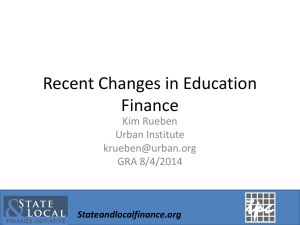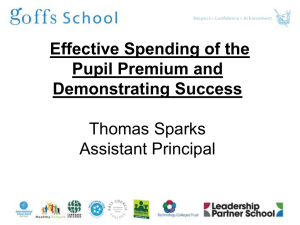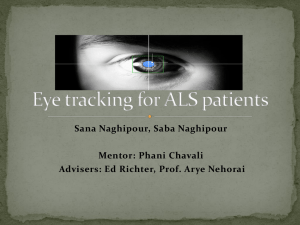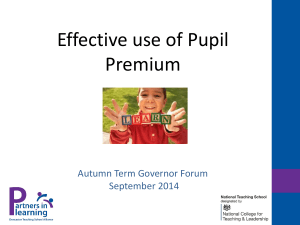Arrangements for Pupil Premium Plus for the Education of Children
advertisement
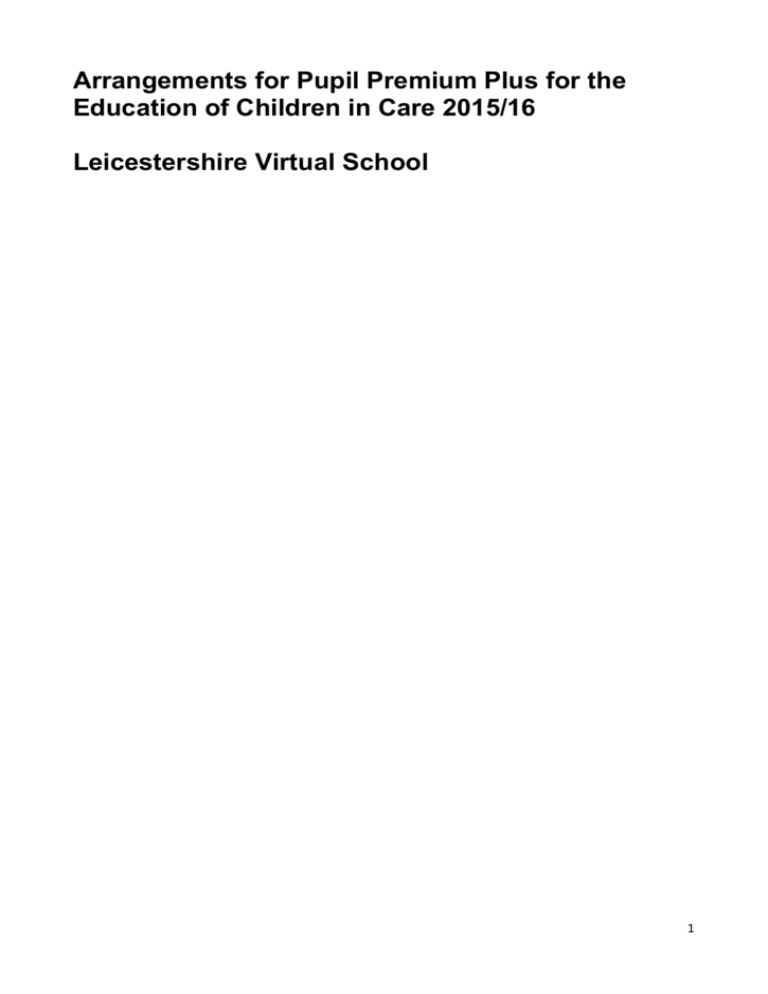
Arrangements for Pupil Premium Plus for the Education of Children in Care 2015/16 Leicestershire Virtual School 1 1. Introduction There were significant national changes in the arrangements for Pupil Premium for Children in Care from April 2014 and our arrangements are informed by two key Department for Education (DfE) documents: Pupil Premium Grant 2015 to 2016 Conditions of Grant (March 2015) (See Appendix 1) Pupil Premium and the role of the Virtual School Head 2014-15 - Frequently Asked Questions (March 2014) (See Appendix 2) Throughout this document, the Pupil Premium for children in care will be referred to as Pupil Premium Plus to distinguish it from other forms of Pupil Premium allocations. The changes are as follows: From 1 April 2014 'Pupil Premium Plus' to support children and young people in care at school increased by £1,000 per pupil to £1,900 per child. Children and young people will now be eligible following one day in care according to the SSDA903 social care census March 2014 and aged 4 – 15 August 2013. Local authorities continue to be responsible for distributing Pupil Premium Plus payments for children in care to schools and academies and where appropriate to nonmainstream settings. However, in addition, Virtual School Heads are responsible for making sure there are effective arrangements in place for allocating Pupil Premium Plus funding to benefit children in care to their authority. The overall grant allocated to each LA will be calculated on a per capita basis. However, it does not have to be distributed on a per capita basis, given that children and young people in care have differing levels of need at different stages of being in care. The grant must be managed by the Virtual School and used to improve outcomes and “narrow the gap” as identified in the Personal Education Plan [PEP] in consultation with the designated teacher. As a result, PEPs will need to be monitored even more closely by designated teachers, the Virtual School team, social workers/team leaders and independent reviewing officers. In addition and through a separate process, children adopted from care, subject to a residency order or special guardianship order from care will be entitled to £1900 passed directly to the school. However, this grant is outside the remit of this policy and will not be distributed by the Virtual School. As a result of the above changes, our allocation of Pupil Premium Plus needs to move to a “child’s needs driven model”, managed through high quality PEPs. 2. Pupil Premium Plus Arrangements 2015-16 2.1. Overall principles underpinning our child’s needs driven model Pupil Premium Plus is to benefit the child in care and must be used to enhance and improve their education. The child in care’s voice and their specific needs are of central importance in considering the use and impact of this money by schools/settings. 2 The Virtual School Head (VSH) is responsible for the use of Pupil Premium Plus to improve outcomes for all children in our care, wherever they live. None of the grant will be used to pay for Virtual School management, administration or core staff salaries. In the academic year 2015-16, all of the grant will continue to be distributed to schools on a termly basis to support all eligible children and young people to improve their educational progress and narrow the achievement gaps between children in care and their peers. Proposals to pool Pupil Premium Plus in a school to enhance services, providing its use is directly linked to individual children in care’s needs via the PEP, are acceptable. Leicestershire County Council and the Virtual School Head are corporate parents, so the question ‘would this be good enough for my child?’ is a central one in making decisions and evaluating the effectiveness of the use of Pupil Premium Plus. 2.2. How and why will the amount of Pupil Premium Plus vary from LA to LA? Children’s needs vary and can change significantly. Children in care may move schools due to care placement moves, infant to junior, primary to secondary, secondary to post-16 and/or undertake in-year changes. Annual allocations of PPP rather than termly allocations. Some LAs may keep money back for the funding of schemes. In view of this, there may be a significant difference in the amount of Pupil Premium Plus distributed by all LAs. 2.3. Circumstances in which Pupil Premium Plus will not be provided Pupil Premium Plus will not be used to replace funding which should already have been allocated to the school to support the child and specifically: o to fund services that should be provided via a statement, SEN support plan or Education Health and Care plan. o to fund other statutory work e.g. statutory assessment or support from Health. Where the PEP action plan does not meet requirements (see section 3.1). Whereas in the past some schools have used Pupil Premium Plus to fund interventions for other learners, interventions which have no link to the individual child in care’s needs will no longer be funded. 3. Management and Accountability The Virtual School Head will be accountable to the Education of Children in Care Strategy Group for setting up a transparent and rigorous allocation process to schools, ensuring that effective use and impact of the grant is monitored, evaluated, supported, and where necessary, challenged. Use and impact of PPP will be clearly recorded in the child/young person’s PEP and in other evaluative documentation held by the Virtual School (see Review document section 3.2). Impact will also be measured against termly progress data returns from schools. Schools and settings are accountable for ensuring that the money is used appropriately and effectively to enhance and improve the child in care’s educational achievement. 3 3.1. Personal Education Plans [PEPs] Schools will be asked to review and detail the impact of PPP in 2014/15 and return this form for evaluation purposes to the Virtual School. We will allocate to each school with a Leicestershire child in care on roll a termly PPP grant on receipt of a completed Pupil Premium Plus Plan from the school identifying how the school will use Pupil Premium Plus for the 2015/16 period, the intended outcomes and making clear the links to the child/young person’s PEP target/s. Pupil Premium Plus must be used to improve educational outcomes for children and young people in care to Leicestershire in the following areas: Academic achievement and progress Wider achievement e.g. in an area in which the child is gifted and talented Transition into the next key stage and/or a new learning provider For example, TG is below national age related expectations in reading. To enable TG to accelerate progress in reading, he will have 40 hours of one to one support at £30 per hour funded by Pupil Premium Plus, membership of Letterbox Club (organised via Virtual School) and 15 minutes a night of reading with foster carers recorded in his reading log. Time period for achievement of this target: September 2014 - July 2015. Measured by: progress from 2c to 3c in Reading, highlighted in termly data returns to the Virtual School. In light of revised Statutory Guidance and feedback over time from children/young people, designated teachers, social workers and other professionals, we are redesigning our Personal Education Plans. Paragraph 41 of the new statutory guidance, Promoting the education of looked after children (June 2104, DfE), states: ‘VSHs should make arrangements for PEPs to be reviewed each school term. This is to ensure that the story of the child’s educational progress is current and continues to meet the child’s educational needs. It is also to ensure that information from the PEP is available to feed into the next statutory review of the wider Care plan.’ Discussions will be held on achieving this for all children in care. However, initially we will continue to hold PEP meetings biannually as a minimum (alongside termly progress data returns and reviews) except where a child in care may be experiencing difficulties or struggling in an education setting when termly meetings should be held as a minimum. 3.2 Allocation of funding to all schools with Leicestershire children in care and recoupment policy Although we are moving to a “child’s needs driven model”, this financial year is a transition year. We have therefore paid all schools a first instalment of £630 in summer 2015, asking schools to inform us how they intend to spend this money. Subsequent 2015/16 payments will be based on a fully costed high quality Leicestershire Pupil Premium Plan and tied to a high quality PEP. (See section 3.1). Pupil Premium Plus will continue to be transferred three times a year in the summer, autumn and spring terms on receipt of the completed Pupil Premium Plan form detailing intended use and intended impact against specific PEP target/s. We will not recoup Pupil Premium Plus where a child moves during the term. We reserve the right to recoup the funding if there is no evidence that the funding is being used to address the child in care’s needs. Pupil Premium Plus for children in care will be transferred directly to the schools via the Leicestershire Finance Team. 4 3.3. Allocation of grant to Leicestershire children in care placed in Out-of-County residential providers and recoupment policy The Pupil Premium Plus allocation will have to be approved by the Virtual School Head, on receipt of a completed Pupil Premium Plus Plan tied to a high quality PEP. We reserve the right to recoup the funding if there is no evidence that the funding is being used to address the child in care’s needs. 4. Pupil Premium Plus for Children and Young People attending Leicestershire schools and settings placed by other Local Authorities Different approaches will be adopted by different LAs, as the contexts vary so much, in terms of number of school-aged children in care, the size of the Virtual School team and the existing operational budget for the Virtual School team (which vary enormously between LAs). Where children are placed in Leicestershire by other local authorities, they will make the PPP payments to schools and determine how much will be paid. Leicestershire schools who have children and young people in care from other Local Authorities on their roll should contact the Virtual Head of the relevant Virtual School to request their Pupil Premium Plus policy as they are responsible for the allocation of Pupil Premium Plus for all school aged children and young people in care within their authorities, even though the child/young person is educated in a Leicestershire school. The name and contact details of other Virtual School Heads can be requested from the Leicestershire Virtual School team. Sally-Ann Harding Virtual Head The Fox Academy: The Leicestershire Virtual School educ.childrenincare@leics.gov.uk 0116 3056097 5 Appendix 1 From the Department for Education Conditions of Grant 2015-2016 https://www.gov.uk/government/publications/pupil-premium-2015-to-2016-allocation Basis of the allocations to the local authority ‘The Department will allocate a provisional amount of £1,900 per child looked after for at least one day as recorded in the March 2014 Data Return (SSDA903) and aged 4 to 15 at 31 August 2013. This allocation will be updated and finalised in December 2015 based on the number of children looked after for at least one day as recorded in the March 2015 Children Looked After Data Return (SSDA903) and aged 4 to 15 at 31 August 2014.’ Use of the LAC Premium ‘The LAC premium must be managed by the designated Virtual School Head (VSH) and used for the benefit of the looked after child’s educational needs as described in their Personal Education Plan (PEP). The Virtual School Head should ensure there are arrangements in place to discuss how the child will benefit from any pupil premium funding with the designated teacher in the child’s education setting. The local authority is not permitted to carry forward funding held centrally into the financial year 2016-2017. Centrally-held LAC premium that has not been spent, or allocated to the child’s education setting, by 31 March 2016 will be recovered.’ In 2014 further enquiries were made to the DfE for clarification and we received the following response:'There is no "right" for the provider (school) to have the £1900 Pupil Premium for CLA. As Virtual School Head teacher you will make a decision on how the money is best used. Some children will not require as much support as others, so in those discussions around the PEP and putting in place that extra support through PPG funding it may be that some support will be more than £1900 and some will be less. If you believe that, usually for those expensive independent providers, all aspects of support for the child (through the PEP) have been covered in the existing package then why would you make a PP payment to the provider? However if you decided that there was even more support that could be provided then you could use it - it would need to be detailed within the PEP and agreed with you as the Virtual School Head teacher . The amount you might use for such support is not fixed (i.e. at £1900) it will depend on what support is being given.' Extract from Edward Timpson’s letter to foster carers dated 3rd February 2014 Last year, I mentioned the important role that foster carers play in improving the education of children in care. I’m pleased to be able to tell you that, from April this year, the pupil premium for children in care will more than double from £900 to £1900 per pupil. We are also extending the eligibility to include those who have been looked after for one day or more. Together with your foster child’s social worker, you should talk to their school about how pupil premium funding is being used to best improve their education. 6 Appendix 2 From: Pupil Premium and the role of the Virtual School Head 2014-15 FAQ We have left in this guidance as although the dates referenced are largely for 2105/16, the messages are still current. What changes have been made to the conditions of grant for the Pupil Premium for looked after children in 2014-15? The conditions of grant state the following: Basis of the allocations to the local authority 16. The Department will allocate a provisional allocation of £1,900 per child for the number of children looked after for at least one day as recorded in the March 2013 Children Looked After Data Return (SSDA903) and aged 4 to 15 at 31 August 2012. This allocation will be updated and finalised in October 2014 based on the number of children looked after for at least one day as recorded in the March 2014 Children Looked After Data Return (SSDA903) and aged 4 to 15 at 31 August 2013. Use of the Looked After Children Premium 17. The grant allocation for Looked After Children must be managed by the designated Virtual School Head in the authority that looks after those children to be used for the benefit of the looked after child’s educational needs as described in their Personal Education Plan (PEP). The Virtual School Head should ensure there are arrangements in place to discuss with the child’s education setting – usually with the designated teacher – how the child will benefit from any pupil premium funding. The local authority is not permitted to carry forward funding held centrally into the financial year 2015-2016. The conditions of grant for the pupil premium arrangements in 2014-15 are published on the Department’s website and can be found here: https://www.gov.uk/government/uploads/system/uploads/attachment_data/file/283193/Pupi l_Premium_CoG_2014-15.pdf What are the changes to the pupil premium arrangements for looked after children in 2014-15? There are three main changes: Firstly, looked after children attract a pupil premium of £1900, more than double the amount they attracted in 2013-14. Secondly, the cohort of looked after children who attract the pupil premium is bigger and includes children looked after from the first day of care rather than, as previously, only those who had been looked after for six months or more. Thirdly, for 2014-15 the pupil premium for looked after children must be managed by the virtual school head in the authority that looks after them. Unlike in previous years, there is no requirement for an authority to pass the funding onto the school where the child is on roll to contribute towards meeting the needs identified in their Personal Education Plan. The presumption, however, is funding is passed to the school and this is strongly encouraged. 7 Why have the arrangements for managing the pupil premium for looked after children changed for 2014-15? The Department has changed the conditions of grant regarding how the pupil premium is managed for looked after children to reflect more effectively the particular challenges of supporting their education. Now that virtual school heads will be statutory they will be responsible as part of the corporate parent role to promote the educational achievement of the children looked after by their authority. Ministers therefore want them to have a greater role in working with schools to ensure that duty is fulfilled. And now local authorities attract pupil premium for children from the first day of care giving the virtual school head management of the looked after pupil premium is administratively less bureaucratic. Does the virtual school head have to manage the budget or can this be delegated to a local authority finance team? The conditions of grant for 2014-15 states clearly that the pupil premium grant allocation must be managed by the designated virtual school head for the children looked after by the authority. This has statutory force. It is a virtual school head rather than a local authority finance team who is best placed to know how to use pupil premium to maximise the benefits to looked after pupils. Virtual school heads should consult finance teams about the best way to distribute funding to schools. Can the Director of Finance dictate that the pupil premium funding is passed directly to schools? The conditions of grant state that virtual school heads should manage pupil premium funding. It is therefore for the virtual school head to decide how the pupil premium for looked after children is managed. That is an important part of how the virtual school head complies with the duty under the Children Act 1989 to promote the educational achievement of the children looked after by the authority. Does the virtual school head have to give the money to schools? There is no requirement to do so. There is, however, a strong expectation that virtual school, heads will pass on pupil premium funding onto a child’s education setting to be used to meet additional needs set out in his or her Personal Education Plan. That can be passed to the school on a termly or annual basis. Any funding not passed down to schools by the end of the financial year will have to be returned to the Department. Does the virtual school head have to give £1900 to schools or can they give a higher or lower amount? The conditions of grant state that grant allocation for looked after children must be managed by the virtual school head. It is for the virtual school head to decide whether to provide £1900 to a school for a looked after child or a higher or lower amount. They can also decide on whether to pay termly or annually. They can also link allocation to the content of the Personal Education Plan as agreed with the school. Can the virtual school head pool funding for some of the authority’s looked after children? The Department expects virtual school heads to manage the pupil premium to ensure that it promotes the educational achievement of all the children looked after by the authority. It may be appropriate to pool some pupil premium for activities to benefit the authority’s looked after children more holistically. For example, it might be appropriate to use this funding to provide training for a group of designated teachers across the authority or a group of Teaching Alliance schools. 8 Equally, a virtual school head might negotiate with a school regarding pooling pupil premium funding for looked after children with the school’s pupil premium to provide an enhanced and more intensive package of support for disadvantaged children generally. Does the pupil premium for looked after children need to be passed to nonmainstream schools? There is no requirement to do so. There should be a discussion about what provision is being delivered and what would be provided in addition to that in accordance with the child’s Personal Education Plan, if the pupil premium funding was passed on to the nonmainstream education setting. Can the pupil premium for looked after children fund a post in the virtual school? Pupil premium is additional funding provided to raise the achievement of looked after pupils and close the achievement gap. It is not intended to fund posts that should be the responsibility of local authorities as a corporate parent. There may be instances where some pupil premium funding can be used to support the work of a person where it can be very clearly demonstrated that their role has a significant contribution to promoting the educational achievement of the children looked after by the authority. That role could, for example, involve working with schools to raise the quality of learning targets in a child’s Personal Education Plan. Can some of the pupil premium for looked after children be spent on providing other central services that support their education? Pupil premium funding is additional funding provided to support schools to raise the achievement of disadvantaged pupils, including looked after children. It should not be used to fund central services that would reasonably be expected to be funded by local authorities, to comply with their duty to promote the educational achievement of the children they look after. As stated above, however, virtual school heads are responsible for managing the efficient use of pupil premium funding for the purpose it has been provided. They will therefore need to demonstrate a direct link between spending and raising standards of achievement for the children looked after by their authority, wherever they are placed. Are virtual school heads accountable for the use and impact of the pupil premium on the achievement of looked after children, in the same way as headteachers? Virtual school heads are responsible for making sure there are effective arrangements in place for allocating pupil premium funding to benefit children looked after by their authority. That means: making sure that pupil premium funding for looked after children is spent effectively and fully, given any underspend needs to be returned to the Department at the end of the financial year; being able to demonstrate how pupil premium funding managed by the virtual school head is linked to raising achievement for looked after children and closing the gap between their achievement and that of their peers; and having arrangements in place to engage with the looked after child’s school (usually with the designated teacher) about how pupil premium funding allocated to the school is contributing to meet the needs identified in his/her Personal Education Plan. Schools are accountable for the educational attainment and progress of all disadvantaged pupils who attract pupil premium on their roll, through Ofsted inspections and KS2/KS4 9 school performance tables. Virtual school heads and others involved in Personal Education Plans will want a constructive dialogue with schools about how best to support looked after children using the pupil premium. The Ofsted framework for the inspection of children looked after services states that, as part of the performance information required, the inspector will ask for the annual report of the virtual school head. We would expect that to include information about how the pupil premium has been managed and the impact it has made. But to whom is the virtual school head accountable within their local authority? That depends on the line management arrangements in individual local authorities. Ultimately, however, the virtual school head is accountable to the Director of Children’s Services and/or the Chief Executive and the Lead Member for Children. How should the funding be allocated for looked after children in 2014-15 when the funding is based on one-year old data in the SSDA903? It is important to distinguish the basis on which funding is allocated to local authorities from SSDA903 data and how that funding is managed by the virtual school head to support those children who are looked after during the 2014-15 period. The provisional allocation is based on the number of children looked after for at least one day and aged 4 to 15 at 31 August 2012, as submitted in the SSDA903 in March 2013. This allocation is updated and finalised in October 2014, based on the number of children looked after for at least one day and aged 4 to 15 at 31 August 2014, as submitted in the SSDA903 in March 2014. This funding should be managed by the virtual head teacher so it is used to support those children looked after by the local authority for one day or more during the 2014-15 period. This needs to take account of the fact that children move in and out of care. How should virtual school heads give schools funding for children who have been looked after for a very short period? It is up to virtual schools heads to manage pupil premium funding for looked after children during the 2014-15 period. Although £1900 is allocated for each looked after child, irrespective of how long they have been in care, this does not necessarily mean that virtual head teachers are expected to manage the funding on the same basis to schools. Virtual head teachers can therefore manage the funding to take account of the length of time in care, as well as other factors, if they wish. The funding, however, should always be to support the educational achievement of the looked after child, as described in their Personal Education Plan. 10 Can the virtual school head carry over pupil premium funding to 2015-16? No. Any pupil premium funding that has not been passed to schools or spent by 31 March 2015 must be returned to the Department. Can we give foster carers the pupil premium to spend rather than give it to schools? The virtual school head manages pupil premium funding to support the education of looked after children, as set out in the Personal Education Plan. The expectation is that this funding is passed to schools unless there are clear reasons not to do this. It should not be used for activity that the local authority should normally be expected to fund as the corporate parent, such as support for foster carers. Foster carers, however, have an essential role in supporting the education of the children for whom they care. Foster carers can therefore make a valuable contribution, such as with the Personal Education Plan. Does the pupil premium for 2014-15 work in the same way as personal education allowances did? No. The pupil premium is not a replacement for the personal education allowance. The pupil premium is much more focussed on support to improve the educational achievement of looked after children and close the gap between looked after children and their peers. Can virtual school heads impose conditions on how schools use the pupil premium for looked after children? We want local authorities to have a constructive and meaningful dialogue with the schools on the most effective use of the funding and not impose conditions. The funding should support children’s Personal Educational Plan, overseen by the designated teacher in the school. Can a school insist that they get £1900 for a looked after child on roll? It is up to the virtual school head to decide how the funding is managed, including how funding is distributed to schools. Although £1900 is allocated for each looked after child, irrespective of how long they have been in care, this does not necessarily mean that virtual head teachers are expected to manage the funding on the same basis to schools. Virtual school heads should also work closely with schools about how best to meet the needs identified in a child’s Personal Education Plan with support provided through the pupil premium. Can an amount be held by the virtual school head to administer the grant? Pupil premium funding is additional funding provided to support schools to raise the achievement of disadvantaged pupils, including looked after children. It should not be used to fund central services such as the virtual school head to administer the funding. The pupil premium should be used to provide additional support for looked after children in order to raise the achievement of looked after children. What tips have virtual school heads got to share about how they have worked with schools up to now in how the pupil premium is used? Talk to other virtual school heads in your area through the virtual school head regional structures. 11 Leicestershire School Pupil Premium Plus Plan The use and impact of Pupil Premium Plus for Leicestershire children in care will be robustly monitored by the Virtual School in PEP meetings and in relation to your termly progress data returns and ongoing pupil progress reviews. Please complete outlining intended use and impact for both the autumn and spring terms 2015/16. Pupil Name: School Name: Designated Teacher: School: Intended Use and Impact of Pupil Premium Plus for Leicestershire Children in Care for both autumn and spring terms 2015/16 Intended Use and How/by whom impact Intended Impact PEP Target Costings will be monitored Has the child or young person been involved in discussion about the use of the Pupil Premium Plus to support their education – Yes or No Please return the completed form By post to: Education of Children in Care Service, Children and Young People’s Service, Room 600, Leicestershire County Council, County Hall, Glenfield, Leicestershire, LE3 8RF Or by email to Pat Barrs, Data Officer: Pat.Barrs@leics.gov.uk Please note if emailing only use young person’s initials and please use separate form for each individual child in care to Leicestershire. 12 Virtual School use only Received on: Targets Checked: Signed: Termly Progress checked: Name: Monies Allocated: Summer/Autumn/Spring Date: Further Discussion with School: Name: Date: Agreed Action: Name: Date: Leicestershire School Pupil Premium Plus 2014 – 2015 Review The use and impact of Pupil Premium Plus for Leicestershire children in care will be robustly monitored by the Virtual School in PEP meetings and in relation to your termly progress data returns and ongoing pupil progress reviews. Pupil Name: School Name: School review of the overall impact of Pupil Premium Plus in 2014/15. Please be specific about what progress has been made against each individual PEP target. Actual Impact of Pupil Premium 2014/15 in Intended Use and PEP Target terms of pupil progress. Costings 13 Has the child or young person been involved in discussion about the use of the Pupil Premium Plus to support their education – Has the child or young person been involved in review about the use of the Pupil Premium Plus to support their education - Yes/no Please return the completed form by … By post to: Education of Children in Care Service, Children and Young People’s Service, Room 600, Leicestershire County Council, County Hall, Glenfield, Leicestershire, LE3 8RF Or by email to Gareth Banks at Gareth.banks@leics.gov.uk Virtual School use only Received on: Signed: Annual Progress checked: Name: Date: Further Discussion with School: Name: Date: Agreed Action: Name: Date: 14

